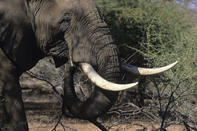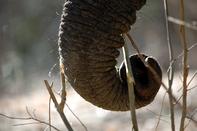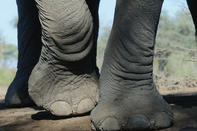Unique Amongst Mammals
Elephants have unique teeth amongst mammals. Each tooth is large and oval in shape, flattened on the surface with transverse ridges of enamelled dentine (to which the generic name Loxodonta refers). They produce six sets of molars in a lifetime.

Two are fully emerged at a time on each side of the mouth on both jaws. The molar in front is gradually worn down as the elephant feeds on an array of coarse material and the next molar then pushes from the back forcing the existing teeth forward to replace the eroding section.
Every new molar is larger than the previous in proportion to the elephant’s changing body size. Eventually, only the final molar M6 remains. Once this tooth has worn away the elephant will slowly starve to death. This happens by 60 years of age, sometimes sooner if the elephant lives in an area where it is prone to eating large quantities of hard, woody material.
The tusks of an elephant are modified upper incisor teeth that grow continuously throughout life. Elephants use their tusks as weapons of defence against predators and other elephants and they are kept sharp for this function. They also use them as tools when foraging to clean soil off vegetation, to dig up items and to lever off branches or bark.
Tusks vary between individuals with some adult animals developing massive tusks while others of the same age may have small tusks or none at all (this is caused by a recessive gene). Tusks may be broken and lost through injury or worn down through usage (generally more on the one side than the other as an individual will be left or right dominant).
Older bulls use their tusks less as their competitive spirit wanes. These individuals may develop enormous ivory as their tusks continue to grow unchecked. The largest recorded tusk in the Lowveld weighed 64.3 kg. The longest tusk on record had a length of 355 cm.
Pack Your Trunk

An elephant’s trunk is a unique apparatus not shared by another mammal world-over. It evolved to assist the elephant with the processing of the large amounts of different sorts of food that it eats. It is formed by the merging of the nose and the muscles of upper lip and it provides a sensitive organ which can be employed as an arm, a straw and a nose.
Comprising thousands of muscles (between 50 000 - 100 000) the trunk can stretch to reach and grasp things or shrink to compact itself for travel. Air is breathed in through the trunk or it may suck up water (litres full at a time) and fruit to place in the mouth or dust to spew over the body. The trunk is powerful enough to break stems or strip whole branches of their foliage but it is also dexterous enough to scoop up piles of small items from the ground or to grasp a single plum-sized berry with the finger-like protrusions at the tip.
It also arranges the food inside the elephant’s mouth to avoid damage from thorny branches. So complex is the fine control involved in operating a trunk that young elephants take some time to master the skill clumsily flopping it around until about 3 months old.
Elephant Feet

Elephants have five toenails on their front feet and four on their hind feet. They use their toenails when feeding. Grasping a tuft of grass in the trunk, an elephant will slice it at the base of the tuft with the toenails to neatly severe the roots and adhering soil to ensure an earth-free mouthful.
Elephant also use their feet to scrape together piles of fruit or to dislodge short grass which can then be scooped up with the trunk. Elephants walk on their toes. The ‘heel’ is supported with a cartilaginous pad that acts as a shock and noise absorber. The pad splays out when the sole of the foot makes contact with the ground and shrinks again when the foot is lifted.
The forefeet are larger to support the enormous weight of the head, trunk and tusks. A particular kind of tinaeid moth only occurs in regions where elephants are found as they specialize in nesting in the sole of a dead elephant’s foot. The hard curled-up sole is long-lasting and provides a safe haven for the developing eggs. Once the eggs hatch, the larvae consume the dried leather before burrowing into the ground to pupate into adults.
Telling the Sexes Apart
Telling male and female elephant apart can be tricky, exacerbated by the fact that bulls have internal testes. Generally, older adult bulls are significantly larger than cows and found alone or in small groups (cows are always in breeding herds).
Younger males and females can be separated by looking at the forehead, which is angled in cows and rounded in bulls. Males also have a straighter back profile than females. Cows have two enlarged mammary glands between their front legs (the only mammal other than primates to have these here) and bulls often relax their penises, which hang down conspicuously.
By Megan Emmett